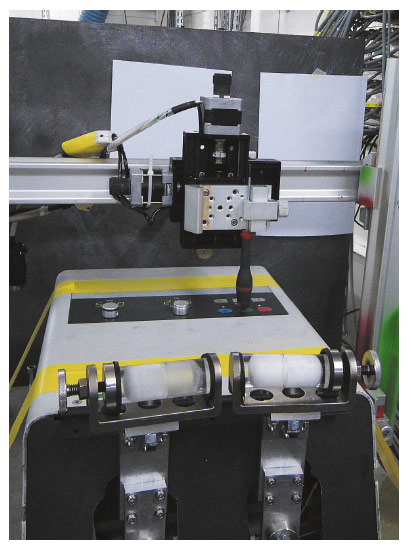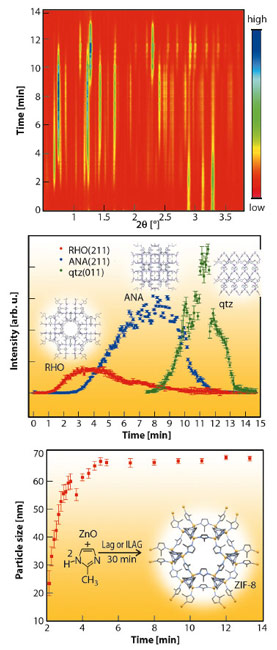- Home
- Users & Science
- Scientific Documentation
- ESRF Highlights
- ESRF Highlights 2012
- Structure of materials
- The first real-time study of a mechanochemical reaction
The first real-time study of a mechanochemical reaction
Reactions induced by mechanical force, also known as mechanochemical reactions [1], have been known and used for millennia. According to recent accounts, the first written record of metal extraction from an ore was performed by grinding cinnabarite (HgS) in a copper mortar in the presence of vinegar [2] – an ancient analogy to the highly efficient liquid-assisted grinding (LAG) methodology used by the modern pharmaceutical industry to discover new solid forms, polymorphs, salts and cocrystals of pharmaceuticals [3]. Despite continuous use from extractive metallurgy to pharmaceuticals, the understanding of mechanochemical reactions remains to a large extent mysterious. This is not surprising, considering the difficulty of directly measuring a chemical reaction taking place in a rapidly moving milling vessel and under intense impact of stainless steel milling balls.
The solution to this long-standing problem was recently devised at beamline ID15B where the excellent penetrating ability of short wavelength X-rays (0.1427 Å) enabled the direct, real-time recording of diffractograms of reaction mixtures being ball milled within the milling vessel operating at a rapid 30 Hz (Figure 123). As the first entry into real-time observation of mechanochemical reactions, we investigated the assembly of porous metal-organic frameworks directly from the simplest metal oxide precursor and using the latest mechanochemical techniques of LAG and ion- and liquid-assisted grinding (ILAG) [4].
 |
|
Fig. 123: Experimental setup for mechanochemical synthesis developed at ID15B. |
The in situ studies provided a direct insight into the kinetics of mechanochemical formation of the porous structure, in situ observation of particle growth, as well as into how changes in catalytic additives and reaction conditions can control and direct the formation of different reaction intermediates. One of the most surprising results coming from this work was the observation of reaction intermediates lasting minutes or less, which would not be monitored or even detectable using conventional stop-and-see approaches.
The methodology that was demonstrated at ID15B provides unprecedented insight into the mechanisms of mechanochemical reactions, both in terms of monitoring reaction kinetics, observing previously unknown intermediate phases and monitoring particle size development (Figure 124). Porous metal-organic frameworks have been proposed as versatile materials in gas storage, catalysis and even light harvesting, and mechanochemical reactions are becoming increasingly important in the context of sustainable chemical synthesis and manufacturing. Consequently, potential applications of the described in situ monitoring methodology await in materials science, but also in mineral extraction, metallurgy, pharmaceutical and cement industry, as well as nanoparticle synthesis.
Principal publication and authors
T. Friščić (a,b), I. Halasz (c,d), P.J. Beldon (b), A.M. Belenguer (b), F. Adams (d), S.A.J. Kimber (e), V. Honkimäki (e) and R.E. Dinnebier (d), Nature Chemistry 5, 66–73 (2013).
(a) McGill University (Canada)
(b) University of Cambridge (UK)
(c) Faculty of Science, University of Zagreb (Croatia)
(d) Max-Planck-Institute for Solid State Research (Germany)
(e) ESRF
References
[1] S.L. James, P. Collier, I. Parkin, G. Hyatt, D. Braga, L. Maini, W. Jones, C. Bölm, A. Krebs, J. Mack, D. Waddell, W. Shearouse, A.G. Orpen, C.J. Adams, T. Friščić, J.W. Steed and K.D.M. Harris, Chem. Soc. Rev. 41, 413-447 (2012).
[2] L. Takacs, JOM 52, 12-13 (2000).
[3] A. Delori, T. Friščić and W. Jones, CrystEngComm 14, 2350-2362 (2012).
[4] P.J. Beldon, L. Fábián, R.S. Stein, A. Thirumurugan, A.K. Cheetham and T. Friščić, Angew. Chem. Int. Ed. 49, 9640-9643 (2010).




